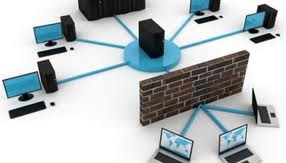
Here are the 4 things you need to do to get you up and running fast
The steps are:
1. prepare all the parts that you need
2. set up your router
3. connect a network client such as a computer or printer
4. do the software set up of the client
1. Prepare all the parts that you need - Make sure that you have purchased broadband Internet either from a DSL provider such as Verizon or from a cable provider such as Cablevision. You need to have received a modem from them and it needs to be connected to a DSL phone line or a cable line which was provided by your ISP (Internet service provider). You should have a router made by Linksys, Netgear, D-Link, Belkin or some other reputable company. You should have at least 2 lengths of network cable.
If you are making a wired network, you should have enough network cables to connect all the parts of the network. Ideally, you will have done the cabling in such a way as to make it the most useful and convenient for yourself. PC Magazine has an article about wiring your home in the best fashion.
If a wireless network is your goal, make sure that you have wireless adapters for all the computers, printers, data storage devices or any other items that you plan to connect to your LAN (local area network). Check in advance that the type of wireless equipment that you are using for the router matches your adapters.
2. Set up your router - Hardware setup:
* Turn off your modem and your router
* Connect a network cable from an available port on your modem to the internet port (usually colored yellow) on your router
* Connect another cable from an available port on your router to a network port on your main computer
* Power on your modem and wait 30 seconds
* Power on your router and wait a minute
Here is a video of the steps listed above.
Software setup:
If you are setting up a wired network, you are basically finished. The router is designed to work out of the box.
There is one more thing than you should do for both a wired and a wireless network. You should change the router password to a secure, hard to guess password. Don't forget this password because if you do you can get back into the router by resetting it but you will lose any settings that you might have made.
Vista requires the following software setup for a wireless network. Open Set Up a Wireless Router or Access Point by clicking the Start button, clicking Control Panel, clicking Network and Internet, and then clicking Network and Sharing Center. In the left pane, click Set up a connection or network, and then click Set up a wireless router or access point.
A wireless network works by broadcasting and that presents 2 problems. 1 - your friendly neighbors (those with a bit of larceny in their hearts) and drive by people with wireless laptops can use your network bandwidth (capacity or power). This would mean that that movie that you wanted to download will take twice as long since someone else is downloading a rock concert on your line also. 2 - Your transmissions are available for hackers to intercept and get private information. To prevent this you need to encrypt (scramble in code) your data transmissions.
Before you try the next 2 steps, make sure your wireless connection is up and running.
To prevent your becoming the wireless provider for your little part of the world, you want to hide the fact that you are broadcasting.
Change the SSID, the name of your wireless network that your router manufacturer provides by default.
Secure your wireless network by activating encryption. Use Wi-Fi Protected Access (WPA) or better yet WPA2 if your router supports it. If not, use Wireless encryption (WEP). For most routers, you will provide a passphrase (a secret sentence) that your router uses to generate several keys. Make sure your passphrase is unique and long.
Click the link for details of doing this for Linksys.
3. Connect a network client such as a computer or printer - For a wired network this means running a network cable from one of the router ports to the network connector of the computer. For a wireless connection, this means making sure that the computer or printer has a network adapter. (If the printer is connected to a computer and the computer is sharing the printer it doesn't need its own adapter.) If it doesn't, install one.
4. Do the software set up of the client - If you have installed a network adapter, install the software that comes with it. For XP, run the Network Wizard. Here is a detailed description of using the wizard.
For Vista, if you have a wireless network, you must first run the Set Up a Wireless Router or Access Point wizard on at least one computer on your network before following these steps.
The procedure consists of 2 steps. 1 Make sure that the workgroup name matches the workgroup name of the main computer. The default name for Vista is WORKGROUP. For XP it is MSHOME. All the computers on the network must use the same workgroup name. 2 For wireless, select the wireless network and provide any needed password. Check that the connection worked.
To manually add a wireless computer running Windows XP
1. Log on to the computer as an administrator
2. Click Start, right-click My Computer, and then click Properties
3. Click the Computer Name tab, and then click Change
4. If the workgroup name is not WORKGROUP, change the name to WORKGROUP, and then click OK. Otherwise, click Cancel to close the Computer Name Changes dialog box. Note: If you have to change the workgroup name, you will be prompted to restart your computer. Restart the computer, and then continue with the steps below
5. Click Start, click Control Panel, click Network and Internet Connections, and then click Network Connections
6. Click the wireless network connection icon, and then, under Network Tasks, click View available wireless networks.
7. Choose the wireless network from the list that appears, and then click Connect
To add a wired (Ethernet) computer running Windows Vista To confirm that you added the computer, do the following:
Open Network by clicking the Start button Picture of the Start button, and then clicking Network.
You should see icons for the computer you added and for the other computers and devices that are part of the network.
To add a wired (Ethernet) computer running Windows XP
1. Log on to the computer as an administrator
2. Click Start, right-click My Computer, and then click Properties
3. Click the Computer Name tab, and then click Change
4. If the workgroup name is not WORKGROUP, change the name to WORKGROUP, and then click OK













